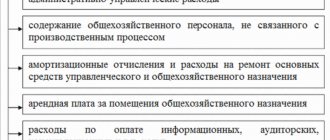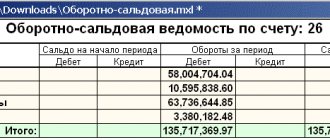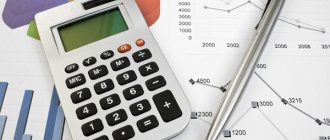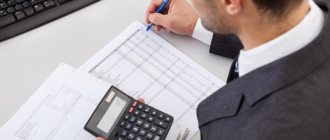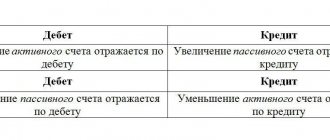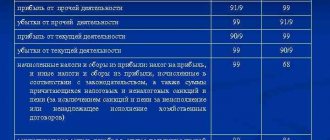An enterprise that produces a particular product invests certain funds in it. An important concept in the formation of profit and profitability of an enterprise is the cost of production. Funds that are invested in the general organization of production, its management, maintenance, etc., make up a significant part of the generated cost.
Let's consider what is included in general business expenses (GEE), what types they can be, how to account for them, and on what basis they are written off. We will analyze the main nuances regarding general operating expenses in production in this article.
General production expenses in the Chart of Accounts for accounting financial and economic activities of organizations.
Accounting: overhead costs
During the reporting period, general production expenses are reflected in the debit of account 25 of the same name. At the same time, expenses are recorded on account 25 in the context of each production unit. In accounting, overhead costs are reflected by the following entries:
Debit 25 Credit 10 – the cost of materials, spare parts used for maintenance and repair of equipment is written off;
Debit 25 Credit 70 – salaries of general production personnel have been accrued;
Debit 25 Credit 69 – contributions for compulsory pension (social, medical) insurance and contributions for insurance against accidents and occupational diseases are accrued from the salaries of general production personnel;
Debit 25 Credit 23 (60, 76) – expenses for maintaining premises are written off (repairs, rent for premises, equipment, payment for utilities, etc.);
Debit 25 Credit 02 (05) – depreciation has been accrued on fixed assets (intangible assets) used in the main (auxiliary) production.
This procedure follows from the provisions of paragraph 9 of PBU 10/99, Instructions for the chart of accounts, letter of the Ministry of Finance of Russia dated November 8, 2005 No. 07-05-06/294.
Using account 25 in accounting
Since account 25 collects information about the organization’s expenses, it is classified as active. The main feature of the account is the absence of balances both at the beginning of the reporting period and at the end. The zero balance is due to the distributive nature of the account. This means that the turnover accumulated during the reporting month is redistributed to other accounts by writing off, and at the beginning of the next period, with a zero balance, the newly spent funds are accounted for.
Costs must be generated for each structural unit of the enterprise.
Due to the lack of information about the initial and final balances, account 25 cannot be displayed in the enterprise’s balance sheet.
Account 25 is a necessary accounting item that helps to calculate and analyze all types of costs included in the production of products. This is especially true in the case when an enterprise produces a large range of product units, and it is not possible to take into account all indirect costs when determining the cost of a released unit.
If the product range is small and is reduced to one dozen product items, it is advisable to classify all indirect costs as main expenses and include them in accounts or.
General running costs
Costs associated with managing an organization, organizing its economic activities, and maintaining its common property are classified as general business expenses.
For example, expenses associated with running an organization (administrative expenses) include:
- administrative and managerial;
- for the maintenance of general business personnel not related to the production process;
- depreciation charges and expenses for repairs of fixed assets for management and general economic purposes;
- rent for general business premises;
- expenses for payment of information, auditing, consulting, etc. services;
- taxes paid by the organization as a whole (property tax, transport tax, land tax, etc.);
- other expenses similar in purpose that arise in the process of managing an organization and are associated with its maintenance as a single financial and property complex.
Kinds
Depending on the direction, ODA is divided into two types:
- Variables.
- Permanent.
The variables include needs that proportionally depend on the growth or decline of production turnover. Before calculating and including variable overhead costs in the cost price, it is necessary to determine the relationship between cost growth and the size of output. Three dependencies are defined:
- Direct dependence of rising costs on increasing production volumes.
- Inverse relationship.
- Cost growth is outpacing production volume.
The relationship between the two indicators (needs and output volume) lies in the rate of wear (depreciation) of the main equipment, the need to increase its power, and the growth of energy and fuel needs.
Constant consumption includes constant consumption, or less susceptible to changes with an increase in output. These are mainly related to the management and accounting needs of the company.
Accounting: general business expenses
During the reporting period, general business expenses are reflected in the debit of the same name account 26:
Debit 26 Credit 10 (21) – materials (semi-finished products of own production) spent on general business needs are written off;
Debit 26 Credit 70 – salaries of administrative, managerial and general business personnel have been accrued;
Debit 26 Credit 69 – contributions for compulsory pension (social, medical) insurance and contributions for insurance against accidents and occupational diseases are accrued from the salaries of administrative, managerial and general business personnel;
Debit 26 Credit 60, 76 – the cost of work (services) performed by third parties (for example, auditing, consulting services) is taken into account as part of general business expenses;
Debit 26 Credit 02 (05) – depreciation has been accrued on fixed assets (intangible assets) for general economic and administrative purposes.
Description and characteristics
Account 25 is used, as already noted, to summarize information about the costs associated with servicing the main production. Taking into account such areas is necessary in order to subsequently include them in the cost of production.
General production costs are taken into account within certain areas:
- 25-1 “Crop production”;
- 25-2 “Animal husbandry”;
- 25-3 "Industrial farms".
Agricultural organizations, as well as auxiliary firms, distribute this type of expenses throughout the year among accounting objects. At the same time, farm and team expenses are attributed to the costs of the department where they occur.
Subscription to electronic publications
Situation: how to reflect in accounting the costs associated with subscriptions to electronic periodicals?
Accounting for expenses for periodical electronic publications depends on the type of contract.
Subscription to electronic periodicals can be issued:
- an agreement for the provision of paid information services for the provision of a copy of a periodical in electronic form (clause 2 of Article 779 of the Civil Code of the Russian Federation);
- a license agreement under which non-exclusive rights to use the electronic resources of the publishing house are transferred (Article 1367 of the Civil Code of the Russian Federation).
In the first case, pay for the subscription to the electronic publication in accounting as an advance payment (clause 3 of PBU 10/99). Reflect the advance payment using the following entries:
Debit 60 subaccount “Settlements for advances issued” Credit 51 – advance payment for subscription to an electronic magazine (newspaper) is transferred.
After receiving the issue of the magazine (newspaper) in electronic form, make the following entries:
Debit 26 (44) Credit 60 subaccount “Settlements with publishing houses” – the cost of the next issue of an electronic magazine (newspaper) is written off as expenses;
Debit 60 subaccount “Settlements with the publishing house” Credit 60 subaccount “Settlements for advances issued” - the amount of the advance is offset against repayment of accounts payable.
This procedure is based on the provisions of the Instructions for the chart of accounts (accounts 60, 44, 26), paragraphs 3, 18 and 19 of PBU 10/99.
In the second case, for accounting purposes, intangible assets received for use are accounted for on an off-balance sheet account in the valuation established by the agreement (clause 39 of PBU 14/2007). The chart of accounts does not provide for a separate off-balance sheet account for accounting for intangible assets received for use. Therefore, the organization needs to independently open an off-balance sheet account and consolidate this in its accounting policies for accounting purposes. For example, account 012 “Electronic subscription publications”.
The one-time payment for the granted right to use the electronic publication should be reflected in accounting in account 97 “Deferred expenses” and included monthly in expenses for ordinary activities during the validity period of the license agreement (paragraph 2, clause 39 of PBU 14/2007).
In accounting, reflect the prepayment by posting:
Debit 60 Credit 51 – the cost of the right to use the electronic publication has been paid.
After gaining access to the electronic publication, make notes:
Debit 012 “ Electronic subscription publications ” – the cost of the right to access an electronic publication is taken into account;
Debit 97 Credit 60 – the cost of the right to access the electronic publication is charged to deferred expenses.
Determine the mechanism for transferring future expenses to cost yourself. The following expenses can be written off:
- evenly;
- in proportion to the income received from sales;
- in other ways.
Determine the period for writing off expenses by the period for which access to the electronic subscription publication was provided. The beginning of this period (the beginning of the period of use of the subscription publication) is determined by the format of the software provided. For example, for the Internet version - from the moment the code is activated.
The period of use of the subscription publication is specified in the contract.
The established procedure for writing off future expenses should be fixed in the accounting policy for accounting purposes (clause 4, 8 of PBU 1/2008, letter of the Ministry of Finance of Russia dated January 12, 2012 No. 07-02-06/5).
Monthly during the period of access to the electronic subscription publication, make the following entries:
Debit 26 (44) Credit 97 – part of the payment for using the electronic publication has been written off.
This procedure is based on the provisions of the Instructions for the chart of accounts (accounts 97, 60, 44, 26), paragraphs 18 and 19 of PBU 10/99.
Attention: many write off deferred expenses at a time. They want to understate large profits of the current period or simply out of ignorance. Officials will be fined for this. In some cases, the organization will also suffer. However, you can avoid trouble.
In accounting, reverse the entry that was written off by the RBP at a time. Remember, this can only be done within the year in which the mistake was made.
r />
For example, the Alpha organization received a certificate of conformity for its products valid for five years. The cost of the certificate was 50,000 rubles. According to the accounting policy at Alfa, RBP is written off evenly.
Error!
Debit 20 Credit 76 – 50,000 rub. – the fee for the certificate is taken into account as part of expenses for ordinary activities.
Correctly like this:
Debit 97 Credit 76 – 50,000 rub. – the fee for the certificate is included in deferred expenses.
Monthly:
Debit 20 Credit 97 – 833 rub. (RUB 50,000: (5 years × 12 months)) – deferred expenses are written off.
Here's how to fix the error in this situation:
Debit 20 Credit 76 – 50,000 rub. – the amount previously erroneously included as expenses for ordinary activities is reversed;
Debit 97 Credit 76 – 50,000 rub. – the fee for the certificate is included in deferred expenses.
At the same time, expense the amounts written off for the past months. For example, if three months have passed since costs were accepted for accounting:
Debit 20 Credit 97 – 2500 rub. (3 months × (50,000 rubles: (5 years × 12 months))) – deferred expenses are written off.
Features of the distribution of cost areas
The distribution of expenses on account 25 occurs on accounts 20, 23, 29 by product types in accordance with the established base. The basis on which indirect costs are distributed is determined according to methodological recommendations that are developed for different industry areas.
The choice of method for allocating expenses from an accounting perspective is based on reporting purposes. Traditionally, the least labor-intensive method is used, which involves the distribution of indirect costs over a common base.
Cost Allocation
General production and general business expenses are associated with the production of different types of products (works, services), and also ensure the operation of the organization as a whole. Therefore, unlike direct (primary) costs, these costs are considered indirect (overhead).
At the end of the reporting period, accounts 25 and 26 are closed. The expenses accumulated on them are written off to the debit of accounts: 20 “Main production”, 23 “Auxiliary production”, 29 “Service production and facilities” or 90 “Sales” in proportion to the indicators that must be established in the accounting policy for accounting purposes (clause 7 PBU 1/2008).
The basis for the distribution of indirect costs between main, auxiliary and service production can be, for example, the following indicators:
- wages of key production workers;
- direct costs with a workshop structure of the organization;
- the number of machine-hours worked for the equipment;
- size of production area;
- material costs;
- volume of production in natural or cost terms.
For example, in industries with a significant share of labor costs, it is advisable to distribute indirect costs in proportion to the salaries of the main production workers. Distribute indirect costs in proportion to material costs (cost of raw materials, materials, spare parts, etc.) if they constitute a significant share of the cost of manufactured products.
An example of the distribution of indirect costs associated with fulfilling a production order. The organization uses the custom costing method
In April, Proizvodstvennaya LLC accepted and completed two production orders (No. 1 and No. 2) for the manufacture of special transport equipment. The accounting policy of “Master” stipulates that general production and general business expenses are distributed in proportion to the salaries of production workers involved in fulfilling each order.
In April, the actual amount of expenses was:
- general production – 100,000 rubles;
- general business – 125,000 rubles.
Direct costs for order No. 1 were:
- cost of materials used – 82,300 rubles;
- salary of production workers - 68,500 rubles;
- the amount of contributions for compulsory pension (social, medical) insurance and contributions for insurance against accidents and occupational diseases from the salaries of production workers is 20,687 rubles.
Total for order No. 1 – RUB 171,487.
Direct costs for order No. 2 were:
- cost of materials used – 151,500 rubles;
- the amount of accrued wages of production workers is 55,000 rubles;
- the amount of contributions for compulsory pension (social, medical) insurance and contributions for insurance against accidents and occupational diseases from the salaries of production workers is 16,610 rubles.
Total for order No. 2 – RUB 223,110.
The total salary of production workers for both orders was 123,500 rubles. (RUB 68,500 + RUB 55,000).
The share of wages of production workers in the total amount of their wages is equal to:
- for order No. 1 – 55% (RUB 68,500: RUB 123,500);
- for order No. 2 – 45% (RUB 55,000: RUB 123,500).
The cost of order No. 1 includes:
- part of overhead costs in the amount of RUB 55,000. (RUB 100,000 × 55%);
- part of general business expenses in the amount of 68,750 rubles. (RUB 125,000 × 55%).
The actual cost of order No. 1 was: RUB 171,487. + 55,000 rub. + 68,750 rub. = 295,237 rub.
The cost of order No. 2 includes:
- part of overhead costs in the amount of 45,000 rubles. (RUB 100,000 – RUB 55,000);
- part of general business expenses in the amount of RUB 56,250. (RUB 125,000 – RUB 68,750).
The actual cost of order No. 2 was: 223,110 rubles. + 45,000 rub. + 56,250 rub. = 324,360 rub.
Production cost
Costs arising in connection with the maintenance or maintenance of production facilities can be attributed to the final result in proportion to the amount specified by the accounting policy. The distribution of overhead costs aims to calculate the cost per unit of production at the exit from the workshop, taking into account all the costs of the industrial cycle.
The distribution of general production and general business expenses when using this method occurs in different ways: from account 25 the amounts are written off to the 20th account, and from 26 to 90. Thus, administrative, managerial and other overhead expenses in terms of general business expenses are not included in the production cost, but relate directly to the financial result.
This is one of the methods that can be applied in an enterprise. Production cost indicators allow you to analyze the profitability of a particular workshop and regulate the amount of costs for the production of certain types of products.
Write-off of general business expenses
General business expenses can be written off in one of two ways:
- to account 20 “Main production” (23 “Auxiliary production”, 29 “Service production and facilities”);
- to account 90-2 “Cost of sales”.
Fix the chosen method of writing off general business expenses in the accounting policy for accounting purposes (clause 7 of PBU 1/2008, clause 20 of PBU 10/99).
In the first case, general business expenses form the “full” cost of finished products and are written off at the end of the month.
Record the write-off of general business expenses (after distribution) by posting:
Debit 20 (23, 29) Credit 26 – general business expenses associated with the activities of the main (auxiliary, servicing) production are written off.
In the second case, a “reduced” cost of finished products is formed, and general business expenses are completely written off for sales, regardless of how many products were sold in the reporting period.
At the moment of transfer of ownership of the shipped products (results of work or services) to the buyer, reflect the proceeds from its sale and write off the cost of the products (work, services) sold:
Debit 62 Credit 90-1 – revenue from the sale of products is reflected;
Debit 90-2 Credit 43 – the actual cost of shipped products (work performed, services rendered) is written off;
Debit 90-3 Credit 68 subaccount “Calculations for VAT” - VAT is charged on sales proceeds.
At the end of the month, write off the amount of general business expenses:
Debit 90-2 Credit 26 – general business expenses are included in the cost of sales.
Such rules are established by paragraphs 5 and 12 of PBU 9/99 and the Instructions for the chart of accounts (accounts 20, 26). For more information about this, see How to record sales of finished products in accounting.
An example of writing off indirect costs for the main and auxiliary production of an organization. The organization accounts for costs at actual cost
LLC "Proizvodstvennaya" manufactures jewelry. In accordance with the accounting policy, for accounting purposes, cost accounting is carried out at actual cost. General production and administrative expenses are distributed in proportion to the salaries of production workers.
"Master" has two workshops:
- Workshop No. 1 – production of machine-made chains and bracelets. An auxiliary repair group has been created on the territory of the workshop, which is engaged in setting up the production equipment of workshop No. 1;
- Workshop No. 2 – production of exclusive handmade products (pendants, earrings, rings).
In addition, the organization has created a design bureau that develops sketches and models of new products for both workshops.
To reflect actual costs by workshop, additional subaccounts have been opened to account 20:
- 20 subaccount “Workshop No. 1”;
- 20 sub-account “Workshop No. 2”.
In April, actual expenses were:
For workshop No. 1:
- cost of consumed raw materials, materials - 1,200,000 rubles;
- salary of production workers - 185,323 rubles;
- contributions for compulsory pension (social, medical) insurance and contributions for insurance against accidents and occupational diseases - 55,968 rubles;
- depreciation of fixed assets used in production - 70,000 rubles.
For workshop No. 2:
- cost of consumed raw materials, materials - 800,000 rubles;
- salary of production workers - 96,368 rubles;
- contributions for compulsory pension (social, medical) insurance and contributions for insurance against accidents and occupational diseases - 29,103 rubles;
- depreciation of fixed assets used in production - 20,000 rubles.
The costs associated with setting up production equipment in workshop No. 1 were:
- cost of materials, parts, spare parts – 60,000 rubles;
- salary of repair group employees (including contributions for compulsory pension (social, medical) insurance and contributions for insurance against accidents and occupational diseases) - 80,000 rubles.
The costs of maintaining the design bureau amounted to:
- designers’ salary – 124,000 rubles;
- the amount of contributions for compulsory pension (social, medical) insurance – 37,200 rubles;
- the amount of contributions for insurance against accidents and occupational diseases - 248 rubles;
- depreciation of office equipment of a design bureau - 43,000 rubles.
The amount of general business expenses for April is 248,000 rubles.
The share of wages of production workers in workshops is:
- shop No. 1 – 66% (185,323 rubles: (185,323 rubles + 96,368 rubles) × 100%);
- shop No. 2 – 34% (96,368 rubles: (185,323 rubles + 96,368 rubles) × 100%).
The amount of general production expenses (costs of maintaining a design bureau), which is distributed between workshops, is equal to: 124,000 rubles. + 37,200 rub. + 248 rub. + 43,000 rub. = 204,448 rub.
The amount of overhead costs, which is included in the cost of production, is equal to:
- for workshop No. 1 – 134,936 rubles. (RUB 204,448 × 66%);
- for workshop No. 2 – 69,512 rubles. (RUB 204,448 × 34%).
The “Master” accountant distributed the amount of general business expenses as follows:
- for workshop No. 1 – 163,680 rubles. (RUB 248,000 × 66%);
- for workshop No. 2 – 84,320 rubles. (RUB 248,000 × 34%).
The following entries were made in the “Master’s” accounting:
Debit 20 subaccount “Workshop No. 1” Credit 10 – 1,200,000 rub. – raw materials transferred to workshop No. 1 were written off;
Debit 20 subaccount “Workshop No. 1” Credit 70 (69) – 241,291 rub. (185,323 + 55,968) – wages accrued to the workers of workshop No. 1 (including insurance contributions);
Debit 20 subaccount “Workshop No. 1” Credit 02 – 70,000 rub. – depreciation was accrued on production fixed assets of workshop No. 1;
Debit 20 subaccount “Workshop No. 2” Credit 10 – 800,000 rub. – raw materials transferred to workshop No. 2 were written off;
Debit 20 subaccount “Workshop No. 2” Credit 70 (69) – 125,471 rubles. (96,368 + 29,103) – wages were accrued to the workers of workshop No. 2 (including insurance contributions);
Debit 20 subaccount “Workshop No. 2” Credit 02 – 20,000 rub. – depreciation was accrued for production fixed assets of workshop No. 2;
Debit 23 Credit 10 – 60,000 rub. – the cost of materials spent on repairing equipment in workshop No. 1 was written off;
Debit 23 Credit 70 (69) – 80,000 rub. – salaries of the repair group employees were accrued (including insurance premiums);
Debit 20 subaccount “Workshop No. 1” Credit 23 – 140,000 rubles. (60,000 rubles + 80,000 rubles) – the costs of auxiliary production of workshop No. 1 are taken into account;
Debit 25 Credit 70 (69) – 161,448 rubles. – salaries of designers were calculated (including insurance premiums);
Debit 25 Credit 02 – 43,000 rub. – depreciation has been calculated on fixed assets of the design bureau;
Debit 20 subaccount “Workshop No. 1” Credit 25 – 134,936 rubles. – general production expenses were written off as the cost of production of workshop No. 1;
Debit 20 subaccount “Workshop No. 2” Credit 25 – 69,512 rubles. – general production expenses were written off as the cost of production of workshop No. 2;
Debit 26 Credit 10 (02, 60, 69, 70) – 248,000 rub. – general business expenses are reflected;
Debit 20 subaccount “Workshop No. 1” Credit 26 – 163,680 rubles. – general business expenses were written off for the cost of production of workshop No. 1;
Debit 20 subaccount “Workshop No. 2” Credit 26 – 84,320 rub. – general business expenses were written off for the cost of production of workshop No. 2.
Direct costing method
An alternative method to traditional calculation is to calculate production costs based on variable costs - this is the “Direct Costing” method. It lies in the fact that the calculation is carried out on the basis of only those costs that are directly related to the production of products, that is, an incomplete calculation of the cost. When using this method, the cost of the product does not include costs that are not directly related to production; they are taken into account as a separate item, and then written off to the financial result when distributing the company’s income and losses.
The Direct Costing method was officially introduced into Russian accounting regulations in 1996. It allows you to more accurately determine the price of products and reduce the distortion of the result due to variable consumption.
Accountants performing calculations are required to ensure the timeliness and reliability of accounting for indirect costs, ensure that they are reflected correctly in accounting registers, and monitor the rational use of production resources and other indirect costs. Only on the basis of accurate information can it be possible to analyze ODA and develop a strategy for reducing it in future periods.
Similar articles
- Dependence of fixed costs on production volume
- Production costs
- General production costs: calculation formula
- General production expenses
- Fixed and variable production costs
General business expenses in the absence of activity
Situation: how to reflect general business expenses in accounting if the organization does not receive income from its activities?
General business expenses (for example, salaries of management personnel, office rental costs and other expenses associated with the development and development of a business), like other expenses, must be taken into account regardless of whether they lead to income or not (clauses 16–18 of PBU 10/99). Therefore, even if the organization does not receive income from its activities, these expenses must still be fully reflected in the accounting accounts.
General business expenses, which are reflected in account 26 of the same name, should be taken into account in one of the following ways:
- write them off to account 20 “Main production”;
- take them into account in account 91 “Other income and expenses” in the subaccount “Other expenses”.
In the first case, general business expenses will be taken into account as part of the main production expenses (i.e., in the debit of account 20 (Instructions for the chart of accounts)), forming the full cost of finished products. When the organization begins to receive income, taking into account these costs, the financial result from sales will be formed (clauses 18 and 19 of PBU 10/99).
In the second case, expenses will directly form the financial result (loss) of the reporting period (i.e., taken into account as the debit of account 91-2) (Instructions for the chart of accounts).
Until January 1, 2011, general business expenses could be taken into account using account 97 “Deferred expenses”. Since January 1, 2011, organizations no longer have this opportunity. This conclusion follows from subparagraph 14 of paragraph 1 of the amendments approved by order of the Ministry of Finance of Russia dated December 24, 2010 No. 186n.
Determine the chosen procedure for distributing expenses in the accounting policy for accounting purposes (clause 4 of PBU 1/2008).
Compound
Costs for general production needs are included in the cost of the trade item (work, services) produced by the company. Their records are kept in each department of the enterprise. They include:
- wear and tear (depreciation) of fixed assets used for the manufacture of goods;
- depreciation (amortization) of other intangible assets used in production management;
- payment for electricity and fuel necessary for the use of production equipment;
- acquisition of spare parts, equipment and materials necessary for setting up and servicing equipment (with the exception of modernization and improvement);
- acquisition of LBP (low-value consumable items), which are necessary for conducting business activities at the enterprise for any needs;
- item of trade with defects;
- remuneration of hired employees involved in the management and production of finished products;
- unforeseen payment of wages to hired employees performing work to produce products.
The above areas are indirect overhead costs; the formula for calculating the cost of production using them will be presented further.
Non-operating income and expenses
Regulatory framework
In accounting, as in any other matter, a special regulatory framework is used, through which the methodology for accounting for costs associated with servicing production and managing the company is determined.
This technique is regulated through a regulatory framework, which includes the following documents:
- decrees and legislative summaries;
- regulations adopted by the executive branch of the Russian Federation;
- regulations and standards applied within the balance sheet;
- reports and statements present in the general set of company documentation;
- instructions and recommendations offered by the Ministry of Finance of the Russian Federation and other government agencies;
- work instructions, instructions, orders;
- government regulations.
Accounting for environmental protection
Accounting
General business expenses are accounted for on active account 26. At the end of the period, they are transferred to account 20 (23) or to account 90. Firms whose activities are non-productive in nature can collect basic expenses on account 26, and then transfer them to account 90 (except trading enterprises).
Postings:
- Dt 26 Kt 76, 70, 71, 68, 69, 60, 23, 29, 10, 05, 02, etc. - reflection of non-production costs. Accounts 23 and 29 are applied if the organization has auxiliary and service industries that provided non-production services for the AUP.
- Dt 20, 23 Kt 26 - write-off of chemical and chemical equipment for main and auxiliary production (if the latter is available in the organization).
- Posting Dt 20 Kt 26 is done by type of product based on the calculations made or in full amount if the company has one type of product. The distribution of chemical and chemical resources between main and auxiliary production can be done in proportion to their production costs for the period.
- When using account 90, the following posting is generated: Dt 90 Kt 26 for the corresponding subaccounts (2 if the company provides external services, 8 if direct costing is used).
Analytics for account 26 is organized by cost items and departments:
- Management expenses (AUP business trips, entertainment expenses, wages with AUP deductions, etc.).
- Business costs (wages and deductions for general business workers and personnel, labor protection, depreciation, etc.).
- Other maintenance costs (utilities, office expenses, postage, etc.).
The given accounting option is only one of the possible ones.
Tax accounting
Costs in NU related to production and sales are divided into direct and indirect (Article 318-1 of the Tax Code of the Russian Federation). At the same time, the list of non-operating expenses (Article 265 of the Tax Code of the Russian Federation) does not allow OCR to be included among them. An organization can independently choose the procedure for attributing certain expenses to one another and enshrine it in its accounting policy (Article 319-1 of the Tax Code of the Russian Federation). Consequently, OCR can be taken into account for NU purposes as both direct and indirect. The main difference is that indirect costs can be taken into account for the purposes of tax accounting in the current period, while direct costs are calculated taking into account the balance of work in progress.
Despite the relative freedom in the issue of dividing costs into categories, the fiscal authorities remind that classifying certain costs as indirect is legal only if there is no real opportunity to take them into account as direct (letter of the Federal Tax Service No. KE-4-3/2952 dated 24.02. 2011 and a number of similar documents).
Firms providing services can fully account for their costs in the current tax period.
Main
- General operating expenses do not relate directly to the production of products.
- Depending on the chosen method, they are either distributed in proportion to the selected basic indicator, by type of product, and then written off according to the nomenclature, or completely attributed to cost, or isolated and attributed to cost using the “direct costing” method.
- In accounting for industrial maintenance, account 26 is provided, which is closed to production accounts taking into account types of products or to account 90.
- In tax accounting, according to the accounting policy for NU purposes, OHR can be classified as both direct and indirect.
